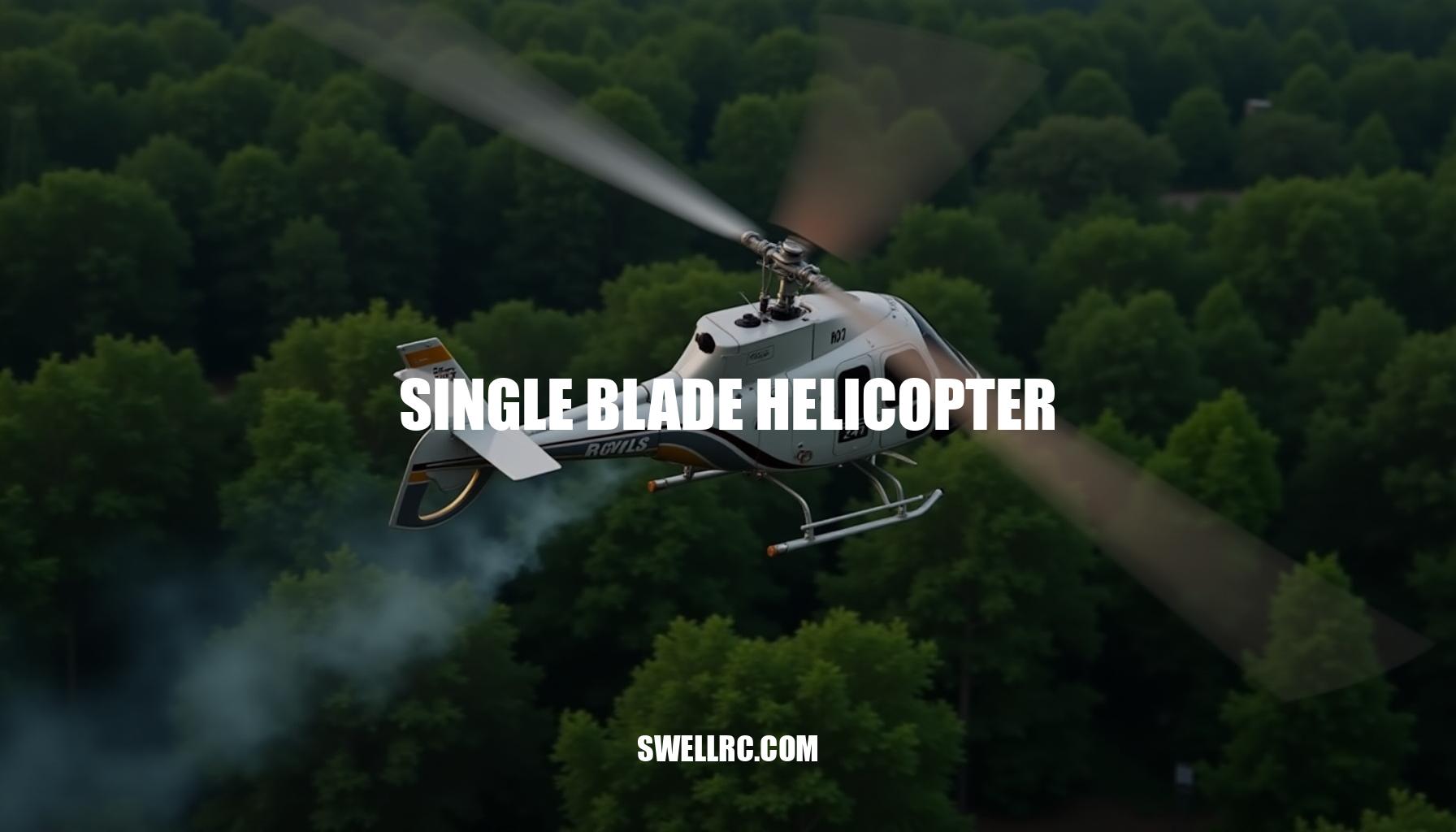Mastering the Art of Single Blade Helicopter Flight
After hours of watching test flights and chasing that perfect hover at dusk, I finally asked the question that changed my flying: why does a single blade helicopter feel so alive in the air? That curiosity sent me down a rabbit hole of swashplates, tail rotors, and minute pitch adjustments—and the results were worth every late-night tweak. In simple terms, a single blade (single main rotor) helicopter uses one primary rotor disc to generate lift and a tail rotor to counter torque, delivering that crisp, responsive handling enthusiasts love.
Engineers admire the elegance of the rotor design; hobby-grade transmitters and radio setups make a huge difference in pilot control, and hobbyists appreciate the precision of single rotor flight. As a pilot invested in understanding helicopter physics, I got hooked on the subtle tuning that makes these remote control aircraft machines sing. From refining pilot inputs to upgrading to a reliable transmitter, the nuances directly improved my flying experience.
If you’re just gearing up, a reliable hobby-grade transmitter makes a huge difference—check out options there to elevate your RC helicopter control and performance.
The Engineering Behind a Single Blade Helicopter
A single rotor flight helicopter operates through the intricate interplay of the main rotor, tail rotor balance, and the swashplate assembly. The main rotor generates lift, while the swashplate is critical for seamlessly mixing pilot inputs to achieve precise blade pitch adjustments. This precise control allows for effective torque compensation, managed by the tail rotor that counteracts the torque produced by the spinning main rotor, ensuring the fuselage remains stable and does not spin uncontrollably.
Two essential pitch controls define maneuverability: collective pitch vs. fixed pitch. Collective pitch changes the overall lift instantaneously, and cyclic pitch tilts the rotor disc for directional movement—forward, backward, or sideways.
Alternatives to the single rotor design include the coaxial helicopter and the tandem rotor configurations. A coaxial helicopter stacks two counter-rotating rotors on the same mast, inherently canceling torque without the need for a tail rotor, providing greater stability but sacrificing some agility. Tandem rotors, like those on a Chinook, use two large rotors mounted fore and aft, excelling in lift and yaw control while managing complexity.
| Helicopter Type | Torque Compensation | Yaw Control | Flight Characteristics | Tail Rotor Required? |
|---|---|---|---|---|
| Single Rotor | Countered by tail rotor (tail rotor balance) | Precise, via tail rotor thrust | Highest agility vs. stability; very authentic flight feel | Yes |
| Coaxial Rotor | Two counter-rotating rotors cancel torque inherently | Yaw controlled by differential rotor speeds | Inherent stability; less agile | No |
| Tandem Rotor | Torque balanced between the two rotors | Good yaw authority by varying rotor thrust | Excellent lift and stability; more mechanical complexity | No |
In essence, the application of swashplate technology combined with blade pitch modulation offers pilots instant and nuanced collective pitch vs. fixed pitch adjustments for lift and movement. While modern flight controllers and gyroscopic stabilization enhance smoothness, the fundamental physics remain elegantly straightforward: blade pitch modulates lift and direction, the tail rotor (if present) manages heading, and all commands flow through the swashplate directly from your controls.
This balance between agility vs. stability defines the unique flying experience of each helicopter design.
The Learning Curve: Flying a Single Blade Helicopter
The first time I eased into a hover, it felt like balancing on air—every micro input mattered. The trick was learning to relax and let the helicopter talk back through the sticks. As a beginner RC helicopter pilot, mastering flight stability is crucial: beginners often over-correct, neglect tail rotor management, or skip proper helicopter gyro setup.
Stabilization helps a ton; after I dialed in my controller settings with appropriate expo and rates and added a dependable gyro (see helicopter gyro), my hover locked in and my transitions got smoother.
For effective pilot training and orientation training, I started with the Double Horse 9101 (Double Horse 9101) to learn basic orientation. Once my throttle and collective discipline improved through consistent hover practice, I graduated to scale models like the Black Hawk (Black Hawk) and the stylish Bell 222 Airwolf (Bell 222 Airwolf), which demand greater control and precision.
Top 3 Tips for First Flight Success:
- Start with gentle hover drills: Practice nose-in, tail-in, and side-in orientations to build confidence and improve flight stability.
- Set conservative rates and add expo: This ensures your inputs are smooth, not twitchy, allowing for better control during hover practice.
- Practice throttle and collective discipline: Tiny, deliberate changes beat big swings every time, especially when managing tail rotor inputs.
Comparing Models: From Military Replicas to Hobbyist Favorites
Over several weekends, I spent time rotating through a hangar of single-rotor favorites to understand what really sets them apart in terms of handling characteristics and overall flight experience. For instance, the Airwolf Black Bell 222 Electric Scale 1:3.5 is a showstopper, boasting an impressive presence and smooth disc loading that’s ideal for cinematic cruising once you’ve gained confidence. Meanwhile, the Horizon Hobby AH-64 Apache feels purpose-built for precision—its confident tail authority and exact cyclic control make it perfect for pilots who want a balance of realistic scale looks and responsive flight characteristics.
Comparing these models against other classics like the UH-60 and Bell 222 variants involved closely examining their build materials, setup tolerance, and durability to create a clear model comparison that can assist prospective buyers.
Below is a buyer’s guide snapshot table outlining key factors such as scale, blade type, flight difficulty, and what each model is best suited for in terms of flying style and experience level:
| Model Name | Scale | Blade Type | Best For | Flight Difficulty |
|---|---|---|---|---|
| Airwolf Black Bell 222 | 1:3.5 | Single-Rotor | Cinematic Scale | Advanced |
| Horizon Hobby AH-64 Apache | Scale | Single-Rotor | Advanced Sport | Intermediate to Advanced |
| UH-60 Black Hawk | Scale | Single-Rotor | Training / Sport | Beginner to Intermediate |
| Bell 222 Variants | Scale | Single-Rotor | Sport / Training | Intermediate |
From my scale RC helicopter tests focusing on single rotor performance, it’s clear that the Airwolf stands out as my personal favorite, delivering a grin-worthy experience that turns every flight into a dazzling mini airshow. Whether you prioritize smooth cinematic flights, precise sports handling, or beginner-friendly setups, this model comparison and buyer’s guide should help you find the best fit based on what handling characteristics, build materials, and flight difficulty you’re comfortable with.
Maintenance and Upgrades for Peak Performance
Single-rotor helicopters reward the meticulous pilot who prioritizes vibration reduction and optimized performance. Regular checks such as inspecting RC helicopter blades for nicks or warps, ensuring proper tail rotor maintenance, and precise pitch control calibration are essential to keep your craft flying smoothly and efficiently. When refreshing your rotor disc, investing in premium composite blades often results in significant performance upgrades; after switching to higher-grade blades and adjusting my pitch curves, my helicopter’s hover felt denser and its forward flight tracked like it was on rails.
A quick maintenance routine checklist includes:
- Check main and tail blade condition: Inspect blades for nicks, warps, or loose grips.
- Verify blade tracking and pitch calibration: Re-level the swashplate to ensure precise control.
- Inspect tail rotor belt/shaft tension and bearings: Confirm smooth rotation to maintain tail rotor efficiency.
- Recalibrate the gyro and confirm sensor mounting: Essential for accurate gyro calibration and eliminating vibrations.
- Tighten frame hardware and landing gear: Even micro looseness can add macro wobble.
- Balance packs and monitor motor temps: Early detection of inefficiencies can prevent issues.
- Log changes: To correlate maintenance tweaks with flight results effectively.
For those seeking reliable replacements, browse quality RC helicopter blades at https://www.swellrc.com/rc-helicopter-blades-for-sale/. Incorporating these steps and quality parts will ensure your single-rotor helicopter performs at its best with minimized vibrations and maximum control.
Conclusion – Why the Single Blade Helicopter Still Rules the Sky
From my notebooks to the flight line, single rotor mastery truly won me over with its clean physics and expressive control. We explored how the main rotor and tail rotor dance to balance torque, why the learning curve feels rewarding (not punishing) with the right setup, and how different scale helicopters bring their own personalities to the air. With a little maintenance discipline and the right performance tuning, these helicopters deliver a rare mix of authenticity and precision flying.
After all the hours in the lab and on the field, I can say without hesitation that mastering a single blade helicopter is one of the most satisfying skills in RC flight. Here’s to more dawn hover sessions, more shared field notes, and a vibrant RC flight community that keeps pushing the boundaries of what our rotorcraft can do.
- Clean physics of single rotor design
- Expressive flight control and balance
- Maintenance discipline for longevity
- Performance tuning tailored to each model
- Authenticity and precision in scale helicopters
- Community-driven learning and support
Frequently Asked Questions
- What is a single blade helicopter and how does it work?
A single blade (single main rotor) helicopter uses one primary rotor disc to produce lift and a tail rotor to counteract torque from the main rotor. Collective pitch changes overall lift, cyclic pitch tilts the disc for directional movement, and tail rotor thrust controls yaw, all coordinated through the swashplate. - Are single blade helicopters more efficient than dual rotor helicopters?
Efficiency depends on the mission. Single-rotor designs are typically lighter and very agile, making them efficient for general flying. Tandem or coaxial setups can be more efficient for heavy lifting or hover stability because they share load across more rotor disc area and cancel torque without a tail rotor. - How do you control the stability of a single blade helicopter?
Stability comes from proper mechanical setup (straight shafts, balanced blades, correct pitch tracking), precise gyro tuning, and smooth pilot inputs. The tail rotor keeps heading stable, while the gyro dampens disturbances so the helicopter holds hover and responds predictably. - What are the best RC single rotor helicopters on the market?
“Best” depends on goals. Scale enthusiasts often love detailed models like Airwolf or Apache replicas, while learners may prefer simpler, durable trainers. Look for solid parts support, predictable handling, and room to grow with collective-pitch capability as your skills advance. - Can beginners fly a single blade helicopter safely?
Yes—start with a stable, beginner-friendly setup, tame control rates, and practice hover drills. Fixed-pitch or assisted collective-pitch models with good gyro stabilization help new pilots learn orientation and throttle discipline safely. - What role does the tail rotor play in single blade helicopter flight?
The tail rotor counters main-rotor torque so the fuselage doesn’t spin and provides yaw control for heading changes. Its thrust is critical for stable hover, coordinated turns, and precise nose positioning during maneuvers.



